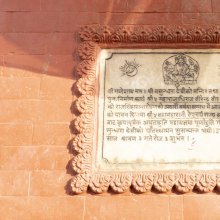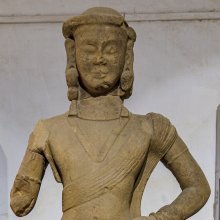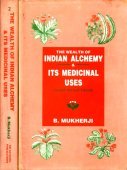Samvat, Saṃvat, Shamvat: 10 definitions
Introduction:
Samvat means something in Hinduism, Sanskrit, the history of ancient India, Marathi, Hindi. If you want to know the exact meaning, history, etymology or English translation of this term then check out the descriptions on this page. Add your comment or reference to a book if you want to contribute to this summary article.
Images (photo gallery)
India history and geography
Source: Cologne Digital Sanskrit Dictionaries: Indian Epigraphical GlossarySaṃvat.—(IE 8-1), originally an abbreviation of saṃvatsara (a year) or any of its declensional cases that can be used in ex- pressing a date; later stereotyped in the sense of ‘a year’ or ‘an era’. It was generally regarded as indeclinable; but we have some cases of the use of forms with case-endings, e. g., saṃvataḥ, saṃvatā, saṃvati and saṃvatām. See also saṃvate (IE 8-1), the seventh case-ending of saṃvata, a corrupt form of saṃvat. Since the late medieval age, the word specially indi- cates the Vikrama era, although originally it was used with the name of any reckoning in quoting the dates of records, especially the regnal reckoning. The word is used in inscriptions in a large number of corrupt forms, e. g., samvata, samvatta, samata, samanta, samatta, saṃmat, samasta, smat, samvatu, samvatū, etc., etc. Note: saṃvat is defined in the “Indian epigraphical glossary” as it can be found on ancient inscriptions commonly written in Sanskrit, Prakrit or Dravidian languages.
--- OR ---
Samvat.—(IE 8-1), mistake for saṃvat, originally an abbre- viation of saṃvatsara. Note: samvat is defined in the “Indian epigraphical glossary” as it can be found on ancient inscriptions commonly written in Sanskrit, Prakrit or Dravidian languages.

The history of India traces the identification of countries, villages, towns and other regions of India, as well as mythology, zoology, royal dynasties, rulers, tribes, local festivities and traditions and regional languages. Ancient India enjoyed religious freedom and encourages the path of Dharma, a concept common to Buddhism, Hinduism, and Jainism.
Languages of India and abroad
Marathi-English dictionary
Source: DDSA: The Molesworth Marathi and English Dictionarysaṃvat (संवत्) [or संवद्, saṃvad].—m (S) A year; esp. a year of Wikramaditya. This era commenced 57 years before Christ.
Source: DDSA: The Aryabhusan school dictionary, Marathi-Englishsaṃvat (संवत्) [-da, -द].—m A year; esp. a year of vikramāditya.
Marathi is an Indo-European language having over 70 million native speakers people in (predominantly) Maharashtra India. Marathi, like many other Indo-Aryan languages, evolved from early forms of Prakrit, which itself is a subset of Sanskrit, one of the most ancient languages of the world.
Sanskrit dictionary
Source: DDSA: The practical Sanskrit-English dictionarySaṃvat (संवत्).—ind.
1) A year.
2) Especially a year of the Vikramāditya era (commencing 56 years before the Christian era).
Source: Cologne Digital Sanskrit Dictionaries: Shabda-Sagara Sanskrit-English DictionarySaṃvat (संवत्).—Ind. 1. A year. 2. A year of Vikramaditya's era.
--- OR ---
Saṃvāt (संवात्).—mfn. (-vān-vātī or vāntī vāt) Blowing, breathing, (as wind.) E. sam before vā to blow, śatṛ aff.
Source: Cologne Digital Sanskrit Dictionaries: Benfey Sanskrit-English DictionarySaṃvat (संवत्).—probably sam-*vat (cf. parut), indecl. 1. A year. 2. A year of Vikramāditya’s era.
— Cf.
Source: Cologne Digital Sanskrit Dictionaries: Cappeller Sanskrit-English DictionarySaṃvat (संवत्).—1. [feminine] side, stretch, streak.
--- OR ---
Saṃvat (संवत्).—2. abbrev. for saṃvatsare in the year (of Vikrama's era, 56 B.[Causative]).
Source: Cologne Digital Sanskrit Dictionaries: Monier-Williams Sanskrit-English Dictionary1) Śaṃvat (शंवत्):—[=śaṃ-vat] [from śaṃ > śam] mfn. (śaṃ-) auspicious, prosperous, [Śatapatha-brāhmaṇa]
2) [v.s. ...] containing the word śam, [Catalogue(s)]
3) Śamvat (शम्वत्):—śamva, śamvat [wrong reading] for śamba and śaṃvat.
4) Saṃvat (संवत्):—[=saṃ-vat] 1. saṃ-vat f. ([from] 2. sam; cf. ni-vat, pra-vat) a side, region, tract, [Ṛg-veda; Atharva-veda]
5) [v.s. ...] = saṃgrāma, [Naighaṇṭuka, commented on by Yāska ii, 17.]
6) [v.s. ...] 2. saṃ-vat ind. (a contraction of saṃ-vatsara below) a year, in the year (in later times [especially] of the Vikrama era [beginning in 58 B.[Calcutta edition] See vikramāditya] as opp. to the Śaka era [in modern times supposed to be founded by Śāli-vāhana; See 3. śaka]; sometimes = ‘in the year of the reign of’), [Inscriptions] etc., [Indian Wisdom, by Sir M. Monier-Williams 494.]
7) [=saṃ-vat] 3. saṃ-vat mfn. containing the word sam, [Śāṅkhāyana-brāhmaṇa]
8) [v.s. ...] n. Name of a Sāman, [Pañcaviṃśa-brāhmaṇa]
[Sanskrit to German]
Sanskrit, also spelled संस्कृतम् (saṃskṛtam), is an ancient language of India commonly seen as the grandmother of the Indo-European language family (even English!). Closely allied with Prakrit and Pali, Sanskrit is more exhaustive in both grammar and terms and has the most extensive collection of literature in the world, greatly surpassing its sister-languages Greek and Latin.
Hindi dictionary
Source: DDSA: A practical Hindi-English dictionarySaṃvat (संवत्):—(nm) a contraction of [saṃvatsara] (see), a year; era (as shak or Vikrami:) year.
...
See also (Relevant definitions)
Starts with (+95): Camvatam, Camvatsaravariyam, Samvat-badhnu, Samvat-suru-garnu, Samvatam, Samvatan, Samvatana, Samvathala, Samvatika, Samvatsalavana, Samvatsam, Samvatsara, Samvatsara-shraddha, Samvatsara-variya, Samvatsara-vimoksha-shraddha, Samvatsarabhrami, Samvatsarabhrit, Samvatsarabhrita, Samvatsarabhritin, Samvatsarabhritokha.
Ends with: Cedisamvat, Isvi-samvat, Saptarshisamvat, Simhasamvat.
Full-text (+115): Samva, Samvattati, Shamvatya, Samvatsarakalpalata, Samvatsaradiphala, Samvatsarayusha, Samvatsaratyasam, Samvatsaradidhiti, Samvatsarabhrit, Samvatsarapradipa, Samvatsarotsavakalpalata, Samvatsarakaustubha, Samvatsaraprakasha, Samvatsarotsavakalanirnaya, Samvatsaraprakarana, Samvatsarakaumudi, Samvatsam, Samvatsarina, Samvatsarakrityaprakasha, Samvatsaranirodhatas.
Relevant text
Search found 40 books and stories containing Samvat, Śaṃ-vat, Sam-vat, Saṃ-vat, Saṃvat, Saṃvāt, Śaṃvat, Śamvat, Sham-vat, Shamvat; (plurals include: Samvats, vats, Saṃvats, Saṃvāts, Śaṃvats, Śamvats, Shamvats). You can also click to the full overview containing English textual excerpts. Below are direct links for the most relevant articles:
Matangalila and Hastyayurveda (study) (by Chandrima Das)
Appendix I: List of Inscriptions
Elephants as fourth or fifth wing of the Royal army < [Chapter 2]
Capturing of elephants in battle-field < [Chapter 2]
Yogadrstisamuccaya of Haribhadra Suri (Study) (by Riddhi J. Shah)
Chapter 2.3 - Date of Haribhadrasūri < [Chapter 2 - Life, Date and Works of Ācārya Haribhadrasūri]
Prasthanatrayi Swaminarayan Bhashyam (Study) (by Sadhu Gyanananddas)
5. Guruparampara in Svāminārāyaṇa Faith: A Live Philosophy < [Chapter 1 - Introduction]
7.2. What to Understand in Upāsanā < [Chapter 4 - Analysis on the Basis of Spiritual Endeavour]
Amaravati Art in the Context of Andhra Archaeology (by Sreyashi Ray chowdhuri)
The Keṭa family < [Chapter 4 - Survival of Amarāvatī in the Context of Andhra Art]
Malatimadhava (study) (by Jintu Moni Dutta)
Part 1b - The Date of Bhavabhūti < [Chapter 1 - Introduction]
A History of Indian Philosophy Volume 3 (by Surendranath Dasgupta)
Part 1 - Teachers and Pupils of the Nimbārka School < [Chapter XXI - The Nimbārka School of Philosophy]
Related products



